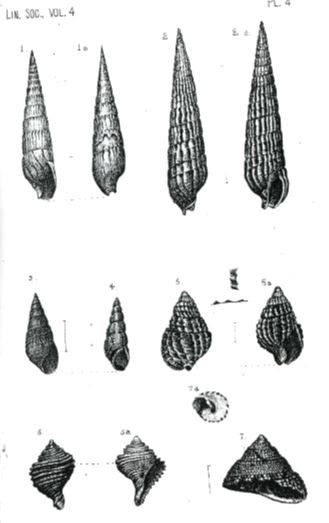Page 24
ON SOME FRESHWATER SHELLS FROM N. GUINEA.
BY THE REV. J. E. TENISON-WOODS, F.G.S., F.L.S., PRESIDENT LINNEAN SOCIETY, N.S.W., &c., &c.
The following shells were placed in my hands for description by the Government Geologist, Mr. C. S. Wilkinson. They were obtained by the missionary expedition to New Guinea.
They appear to me to be new, but in such a large and variable genus which already numbers over 500 species, it is rather difficult to pronounce with certainty without a very complete series of types for comparison. I note the species however, and give them names ad interim. It may be mentioned that though all the Australian Melanias are very wide-spread, some extending as far as New Caledonia, none of them were found in this collection and the general facies of the fluviatile molluscan fauna of New Guinea is peculiar and diverges from the Australian and Pacific types.
MELANIA DAKTULIOS. Pl. 4, fig. 3.
M.t. parva, elongato-ovata, apice acuto, sub-diaphana, intense olivacea, fere atra, haud nitente, anfr. 6 1/2, (nucleo, decoll.) vix convexis„ obsolete interdum costatis, regulariter, distanter spiraliter striatis; striis post columellam crebris, tenuibus; sutura haud impressa; apertura integra ovata, labro tenui, antice producto, columella inconspicuo. Long. 11, lat. 5, long. spirae 6 1/2.
page 25
Shell small, elongately ovate, with an acute spire, intense olive green, approaching black, but sub-diaphanous with transmitted light when the shell is a pale sea green, not shining; whorls 6 1/2, (with the nucleus decollated,) scarcely convex, sometimes obsoletely ribbed, regularly, distinctly striate spirally, these striae are close and fine behind the columella. The suture is not impressed, but sometimes rendered faintly corrugate by the obsolete ribs. Aperture entire ovate, labrum thin, produced anteriorly, columella inconspicuous, but slightly flattened in front.
MELANIA WILKINSONII. Pl. 4, fig. 4.
M.t. elongato-turrita, spira attenuata, nitente, pallide olivacea, maculis vel strigis fulvis, longitudinalibus ornata; anfr. 6-7, elongato rotundatis, declivibus, crebre spiraliter sulcatis, interdum indistincte, longitud. costatis; sutura, bene impressa; apertura ovata, labro tenui, antice producto; labio tenuissime reflexo. Long. 10-20, lat. 3-7. long spiroe 2/3 circiter totius testoe.
Shell elongate with the spire attenuate, but sometimes ovate with an almost conical spire, thin, shining, pale olive with spots or stripes of pale brown disposed lengthwise. Whorls 6 to 7 elongately rounded, sloping, closely, spirally grooved, and in many specimens indistinctly ribbed lengthwise; suture well impressed; and in the upper whorls having a constricted appearance; aperture rather broadly ovate, labrum thin, produced anteriorly, lip very thinly spread. over the columella, which is sometimes rounded, sometimes flattened anteriorly.
The difference between this shell and the preceding is that it is narrow, attenuated in the spire, pale olive, spotted with brown, and very closely spirally grooved, while the grooves on M. daktulios are very distant.
MELANIA SCALARIFORMIS.
M.t. elongata, pyramidata, intense olivacea, opaca, solida; anfr 7, decollatis fere planatis, vix declivibus, eleganter costatis; costis regularibus, crebris, rotundatis, parum curvatis, a sutura ad suturam
page 26
permanentibus, ultim. anfr. evanidis, interstitiis regulariter striatis; apertura late ovata, postice attenuata, labro tenui, antice producto, labio reflexo, haud lato, peripheria obtuse vel subacute angulata. Alt. 10-20, lat. 3 1/2-8.
Shell elongate, pyramidal, intense olive, opaque, solid; whorls 7, always decollate, almost flat, scarcely sloping, elegantly ribbed; ribs regular, close, rounded, slightly curved, remaining the same from suture to suture and disappearing on the last whorl, interstices regularly striate, aperture widely ovate, attenuated posteriorly, labrum thin, produced in front, lip reflected, not wide, periphery obtusely, or in small specimens, subacutely angular.
I am not sure that this should not be regarded as a mere variety of the M. Wilkinsonii. The ribs vary much in all the specimens, and as they are faintly present in the last named shell and the spiral grooves are the same, intermediate grades of the other features may be found. They appear to occur in equal numbers in the same localities. It may even be that all three species here enumerated are varieties of one shell. I have not figured the above, having no specimen sufficiently perfect.
EXPLANATION OF FIGURES.
Plate IV.
Fig. 3. - Melania daktulios.
Fig. 4. - Melania Wilkinsonii.
